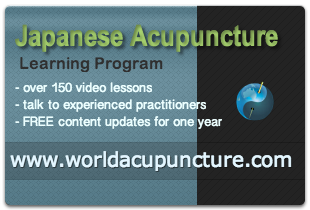World Acupuncture Video Update plus FREE You Tube Video.
There is a FREE video response to a pertinent forum question regarding the use of Ki.7 in Japanese Acupuncture at the end of this blogpost.
These videos were taken at the recent “Bridging The Gap Between TCM And Japanese Acupuncture” seminar held by World Acupuncture in Brisbane.
In this video you will see Alan applying a Kidney Deficiency root treatment (tonifying needling on LU-5, KI-7).
You will learn more about how to breathe, where and how to focus and what you should be doing with your hands. Alan explains a bit about the energetics of and power behind the root treatment. There is a demonstration of how to find the active location of KI-7. Alan also gives a few guidelines for selecting needle depth and also on how to handle guilt over poor results.
In this video Alan is retaining needles in a patient’s back after a lung deficiency liver excess root treatment. You will see him locate and needle GB-20, 21, BL-13, 18, 20 and 23 (BL-58 is also needled off camera). Alan talks about the importance of covering the patient up and ensuring that they are warm and comfortable. Finally you will see Alan applying dispersive scatter needling around the area of BL-18 to address the liver excess.
In addition to the above video I have recorded an answer to the following question on the world acupuncture forum at http://www.worldacupuncture.com/members/cfmbb/messages.cfm?messageid= A08F8349-1422-1A86-5E62B3542870EF6D#A08F8349 -1422-1A86-5E62B3542870EF6D
‘Hey guys.
Its something that i have always thought about and wondered, but never actually asked, so here i go
Why do we use KID7 for a yin deficient patient, opposed to 3?
From a complete theory background, the texts state that it tonifies Yang Ki strongly.
Where KID3 is said to tonify Yin Ki?
I understand that the earth point in this case will nourish the yang aspect, but from experience of using KID3 it seems to be very effective in drawing the heat down from the chest and upper burner.
This being said, i always use LU5 and KID7 as a part of the Kidney yin root treatment. How exactly does this tonify the yin aspect?
I understand that LU5 sends a cooling energy down to the kidneys, being the water point, but wouldn’t KID3 work better to help root this?
Even tho it confuses me, i have being using KID7 to great benefit in treatment of Yin Ki.
Does the metal aspect of KID7 have a job in circulating the moisture sent down by the lung?
Any help would be greatly appreciated Every loose end i tie up pours more petrol on my intention and i believe the effectiveness of Tx outcome.
FREE You Tube video response to Chris’s question
All the Best,
Alan
Alan Jansson is an internationally recognized teacher and practitioner of Traditional Japanese Acupuncture. For over 15 years, independent of and in conjunction with Masakazu Ikeda sensei and Edward Obaidey, Alan has presented, convened and hosted more than 50 Japanese Acupuncture workshops in Australia, New Zealand, USA and the Czech Republic. Driven by a strong desire to promote the consumer friendly nature, clinical efficacy and potency of Meridian Based Japanese Acupuncture, Alan is a staunch advocate of practically based workshops and draws upon his 25 years clinical experience and 15 years post and undergraduate teaching in a concerted effort to lift the bar globally in the clinical application of this most amazing medical art.
Join him in Exploring the Art of Acupuncture in the 21st century at : http://www.Worldacupuncture.com

Speak Your Mind